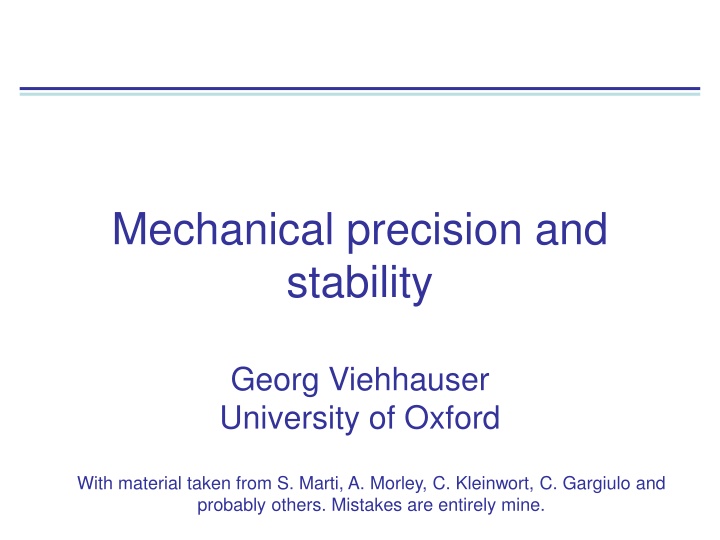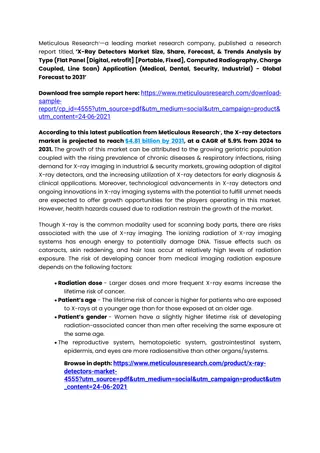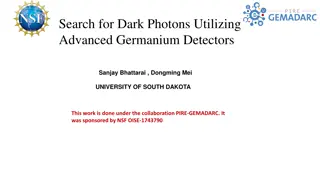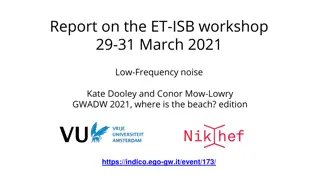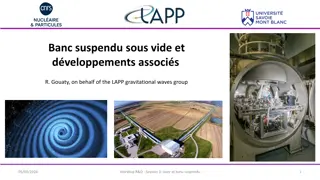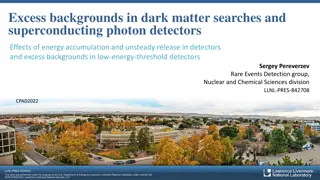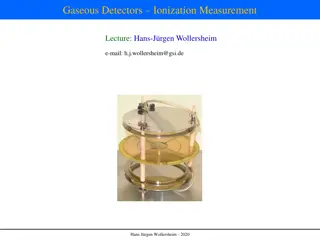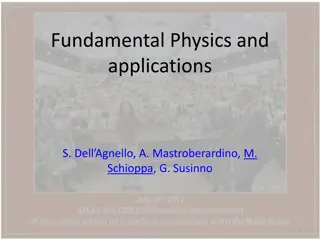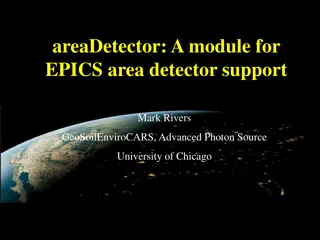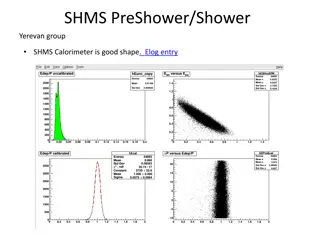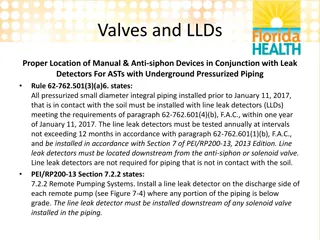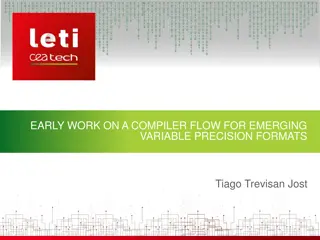Mechanical Precision and Stability in Tracking Detectors
Positioning requirements and methods for tracking detectors, focusing on mechanical engineering support for offline software alignment to ensure stability and performance.
Download Presentation

Please find below an Image/Link to download the presentation.
The content on the website is provided AS IS for your information and personal use only. It may not be sold, licensed, or shared on other websites without obtaining consent from the author.If you encounter any issues during the download, it is possible that the publisher has removed the file from their server.
You are allowed to download the files provided on this website for personal or commercial use, subject to the condition that they are used lawfully. All files are the property of their respective owners.
The content on the website is provided AS IS for your information and personal use only. It may not be sold, licensed, or shared on other websites without obtaining consent from the author.
E N D
Presentation Transcript
Mechanical precision and stability Georg Viehhauser University of Oxford With material taken from S. Marti, A. Morley, C. Kleinwort, C. Gargiulo and probably others. Mistakes are entirely mine.
Introduction The question I will discuss: How to set the positioning requirements for a tracking detector? I will not discuss how to achieve them (if you are interested in this see for example C. Gargiulo s talk at the ECFA High Luminosity LHC Experiments Workshop) Based on experience in ATLAS From what I know CMS experience is similar It should be noted that the solutions implemented for the LHC experiments were conceived at a time when there was no experience with tracking systems of that size My personal background: My main interest are mechanical structures and thermal management I am not a software track-based alignment expert We are going through all this at the moment for the phase II upgrade of the ATLAS tracker Oxford has been the main responsible group for designing, building and operating the FSI alignment system of ATLAS 2
Positioning requirements For a tracking detector (spectrometer or vertexing) we need to know sensor positions in the coordinate system of the tracker Well enough to not significantly degrade performance due to intrinsic resolution This is achieved by Placement accuracy Surveys during/after assembly Surveys during operation (hardware alignment system) Offline software track-based alignment (TBA) Out of these TBA is the most powerful and important Mechanical engineering needs to support this wherever possible This should drive the positioning requirements for the mechanical engineering 3
Offline software alignment Minimize global 2 computed from residuals from high quality tracks Global fit of all track and alignment parameters simultaneously (a few 105 parameters) This might seem daunting, but efficient algorithms have been developed for this, which appear strong enough for even larger systems To make the software alignment more efficient a hierarchy of alignment structures is used This matches the real mechanical structures In ATLAS: Level 1: subsystems (e.g. pixel barrel) Level 2: disks or barrels Level 3: individual modules (assumed to be internally stable) Experience shows that most movements are at level 1, higher level alignment only needed 2-3 per year Track-based alignment by its nature is done for extended periods (alignment cycles) The key demand from the structures is that they are stable over these periods 4
Offline software performance The current understanding is that this technique is capable of aligning the detector modules to a very few m Simplest metrics is to look at unbiased residuals I suspect that the achievable precision scales with the space-point accuracy 5 ATLAS-COM-CONF-2014-046, https://cds.cern.ch/record/1708941
Weak modes There are classes of deformations (weak modes) which do not alter the 2 of the alignment fit Coherent deformations, typically internal to one-subsystem (barrel, endcap) Parameters from the fit are completely undefined (floating) Weak mode deformations can be introduced by any high-level alignment They can be introduced by the software alignment (they do not need to be real deformations) In current alignment constrained by additional means (cosmics, mass peaks, etc.) These are coherent and large-scale internal deformations In principle probably easy to control by mechanics Described by small number of parameters could probably be controlled by targeted hardware alignment This has not yet been tried f(r) f( ) elliptical clamshell skew f(z) bowing twist z expansion r z radial expansion curl telescope 6
Placement and surveys during build Because the track-based alignment is so capable placement is not required to extreme levels of accuracy This is something which was with hindsight overdone in ATLAS Placement only needs to be good enough to Allow everything to fit together Maintain HV isolation clearances Maintain overlaps for coverage and alignment Overlaps provide important constraints for the alignment (in particular circumferential) About 5 detection elements overlap needed (edge + cluster size) Should only be omitted if detection elements are on the same local supports (with some confidence that these are reasonably stable) Placement accuracy adds to overlaps Knowledge of internal dimensions (by construction or survey) can be useful to reduce parameters at the highest alignment levels In practice this will be only possible locally Important caveat: Trigger requirements might supersede the above in future trackers Or the other way round: The trigger needs to not rely on precise placement or needs to be able to accept alignment constants from offline alignment 7
Stability requirements Stability is the most critical requirement for the mechanical engineering of precision tracking systems A definition of stability needs the definition of the timescales and the loads for which the system has to be stable Timescales can (should) match timescales of alignment cycles at different alignment levels These definitions should be used throughout the project Can affect requirements for e.g. cooling, front-end electronics etc. In principle the response of the system to these loads can be predicted from FEA and verified by prototypes In practice this task might be made easier by allocating a stability budget for different levels of the mechanical structures (because understanding smaller structures is easier) 8
Stability experience Very high stability has been achieved Main perturbations are from external sources (magnet ramps, power supply switch, cooling stops etc.) Between these stability is at the level of a very few m Stability at level 1 (large sub-structures) Internal stability probably better 9
Short term loads: Vibrations External vibrations can be characterized by a power spectral density (typically acceleration spectral density ASD) Given by ground vibrations + vibration sources from the rest of the experiment Typical ASDs in particle physics experiments are low (10-7g2/Hz or lower) Other sources of internal vibrations (e.g. cooling) should be avoided by design The displacement response can then be calculated from FEA Simple estimates can be found using Miles equation 1 m RMS displacement for a resonance frequency of 50 Hz at an ASD of 10-7g2/Hz (Q=12.5) ATLAS tracker supports ALICE TPC 10
Other loads Short timescales ( 1d): Thermo-mechanical loads: result from changes of the temperatures of the structures, in particular If the temperatures change locally and/or Different parts of the structure have different thermal expansion coefficients (CTEs) Heat load power changes cause temperature changes in two ways: Local temperatures change according to thermal impedance to local sink Sink temperature can change as well Difficult to predict, preferred strategy is to design constant heat loads Medium timescales ( 1mo): External ( seismic ) events: Cooling system stops, magnet ramps etc. Increased temperature and humidity variations Long timescales Creep and relaxation due to static loads Requirements similar to original placement requirements 11
Alignment to other systems Tracker alignment to the magnetic field Rotations These can be seen as a weak mode: again reconstruct and correct mass peak dependence on and Requires quite a lot of data No real handle on translations Tracker alignment to other sub-detectors This is less critical because of resolutions and intermediate material Typically undemanding because lots of tracks available for relative alignment 12
Hardware alignment systems Both, ATLAS and CMS, have hardware alignment systems in strip sections ATLAS: Frequency Scanning Interferometry (FSI) system Grid line array of 842 lines between Barrel and EC Independent of sensors (mechanically and in terms of readout) FSI can in principle provide sub-micron absolute distance information CMS: Laser alignment system 434 modules (3%) are illuminated by laser beams Read out together with regular data taking (100Hz in orbit gap) Prime motivation for such systems at the time was unknown environment of a detector of unprecedented size Currently both systems are not used in the alignment other than to provide independent quick monitoring of perturbations which require start of a new alignment cycle The fact that they are not used reflects the fact that the anticipated need for these systems did not materialize The systems have not had to demonstrate their ability to provide useful alignment constants for the reconstruction These systems are still the only systems which allow the study of fast deformations 13
Other requirements for the mechanical engineering Positioning requirements are not the only requirements needed for mechanical engineering Other requirements Multiple scattering material This is most in tension with positioning requirements Radiation hardness Thermal management Integration of heat paths into the mechanical design Integration requirements Size and shape of mechanical structures will be driven by the need to achieve a fast, robust construction of the system (including QC) Installation and access scenarios In particular if activation of the detector and environment is a concern These will define separations, interfaces and clearances Cost Not only cost of materials, but including prototyping, manufacturing, yields, repairs etc. 14
So what are the numbers we are discussing in ATLAS?... These numbers are all under discussion Stability Table 1: Summary of stability requirements in r . Stability requirements in other directions are ten times higher. Based on performance we think we achieved in Run I Short Timescale 1d Requirement 2 m Comment Always within sub-systems, on a global scale only between seismic events Medium 1m 5 m Long Several month to years as assembly placement accuracy Hermeticity for 1 GeV/c tracks, 5 strip/pixel overlap for straight tracks (1-2 edge, 3 for cluster), vertex within 1 mm radius of tracker center Placement accuracy on top of this not defined, to be chosen by pixel/strip projects, which will involve optimization for integration and material Other constraints Table 1: Constraints on dimensions which are difficult to track for track-based alignment (Difference between true positions and known positions after placement and surveys). This is the most demanding/controversial requirement It tries to support TBA by constraining the dimension in which it is weak Limit 10 m (pixel barrels) 100 m (strip barrels) r 15 20 m (pixel disks) 100 m (strip disks) z
How to approach this for the LC I think it is necessary to form a team of mechanical engineers + software alignment experts They should develop from the beginning a system which is optimized for alignment Part of this would be to develop mutual understanding From engineers to software alignment: Input for simulation what are possible deformations? What are reasonable limits on what can be achieved? We can offer to target certain deformations by either stiffening them through design, or tracking them with dedicated hardware alignment. Is this useful? From software alignment to engineers: Requirements for mechanical performance, layout, need for hardware alignment 16
Summary The LHC experience: Track-based alignment is the most powerful alignment tool Alignment at the level of a very few m has been achieved. It can even find sensors shape parameters Mechanical engineering should support this as much as possible The critical requirement for the structures is stability High stability is achievable because loads are small or can be made small Placement accuracy is only required to maintain overlaps and clearances (Local) surveys can be useful, but are not essential Hardware alignment systems have very little use for the actual detector alignment Future experiments: I expect all these conclusions to apply for any future tracker My advice is to form from early on a strong collaboration of mechanical engineers and software alignment experts to develop good understanding of each other and a common strategy from the beginning This will allow to specify useful positioning requirements for the mechanical structures 17
Miles equation For a 1dim harmonic oscillator under gravity F 1 g k c 0= f Frequency of first fundamental mode: sag 2 Response to uniform vibration spectrum described by Miles equation y m Miles' Equation (SDOF Response, Fn=200 Hz, Q=20) 1d oscillator response Response Quality factor, typically ~12.5 for CF structures = aRMS ASD f Q 100 0 2 10 Q 1 Acceleration Spectral Density (typically in g2/Hz, FT of time-based acceleration measurement) ASD (G2/Hz) 0.1 White noise input 0.01 White Noise Input SDOF Response 0.001 0.0001 0.1 1 10 100 1000 10000 Frequency (Hz) John W Miles For purposes of order of magnitude estimates this will also apply for 3d objects, although one needs to watch out for coincidences of structural resonances and peaks in the ASD spectrum 22
Displacement response to vibration 3 2 f 4 ASD Q 1 ASD Q Displacement response grav = = = a RMS RMS 3 3 2 2 f g 32 0 0 400 4 1.E+03 f0 displacement response [ m] dRMS @ 10-7 g2/Hz displacement response [ m] 1.E+02 300 3 dRMS @ 10-8 g2/Hz 1.E+01 f0 [Hz] 200 2 1.E+00 10Hz 50Hz 100Hz 150Hz 1.E-01 100 1 1.E-02 0 0 1.E-03 0 100 200 300 400 500 1.E-10 1.E-09 1.E-08 1.E-07 1.E-06 1.E-05 1.E-04 static deflection under gravity [ m] PSD [g2/Hz] To maintain a displacement response of 1 m for an ASD of 10-7 g2/Hz the first mode needs to be at 50 Hz (assuming Q=12.5) This would be equivalent for a static gravitational sag of about 100 m (1d) 23
Damping Damping is to a large extent driven by the materials In CF composite structures it s dominated by the matrix material and the fibre orientation Typical values in literature for damping in high- modulus CF structures are between ~1-5%, where the lower number is along unidirectional fibres and the upper for larger angles. More complex lay-ups somewhere in between This results in Q~1/2 between 10 and 100 Larger structures will probably be much stronger damped due to parasitic (non-support) connections (e.g. services) 24
ATLAS FSI system A geodetic grid of length measurements between nodes attached to the SCT support structure All 842 grid line lengths are measured simultaneously using FSI to a precision of <1 m Only small and passive components within tracker Allows an absolute length measurement (but only of the grid, tells you nothing about individual modules) Width 5mm Height 2.5mm Length 9mm 25 Diameter 2.5mm
ATLAS FSI examples Note that these are timescales which are inaccessible to TBA (days and below) 26
How can we achieve stiffness? The key is design for large moment of inertia (together with high modulus) Ladders are poor Large cylinders are better But: hoop stiffness is now the challenge Also: integration of large cylinders has many disadvantages Large, valuable objects difficult to move/transport Technologies get challenged late in the integration Can one make smaller units which are clever structurally? Yes, exploit the mouldability of CF (and Kapton-based service elements)! Examples exist for vertex/pixel systems, need to scale by 10 in size ATLAS phase II pixel STAR PXL ALICE Pixel doi:10.1016/j.nima.2006.04.093 doi:10.1016/j.nima.2013.07.005 doi:10.1016/j.nima.2010.12.006 And, with 50 m sensors, the structures do not need to be flat 28
Further reading ATLAS collaboration, Alignment of the ATLAS inner detector and its performance in 2012, ATLAS-COM-CONF-2014-046 (2014). CMS collaboration, Alignment of the CMS tracker with LHC and cosmic ray data, 2014 JINST 9 P06009; doi:10.1088/1748- 0221/9/06/P06009. S.M. Gibson et al., A novel method for ATLAS FSI alignment based on rapid, direct phase monitoring, 11th International Workshop on Accelerator Alignment, DESY (2010), ATL-INDET-PROC-2010-037. B. Wittmer et al., The laser alignment system for the CMS silicon microstrip tracker, Nucl. Instr. Meth. A581 (2007), pp. 351-355; doi:10.1016/j.nima.2007.08.002. C. Kleinwort, F. Meier, Alignment of the CMS silicon tracker and how to improve detectors in the future, Nucl. Instr. Meth. A650 (2011), pp. 240 244; doi:10.1016/j.nima.2010.11.187. M. Gersabeck, Alignment of the LHCb vertex locator, Nucl. Instr. Meth. A598 (2009), pp. 71 74; doi:10.1016/j.nima.2008.08.112. 29
